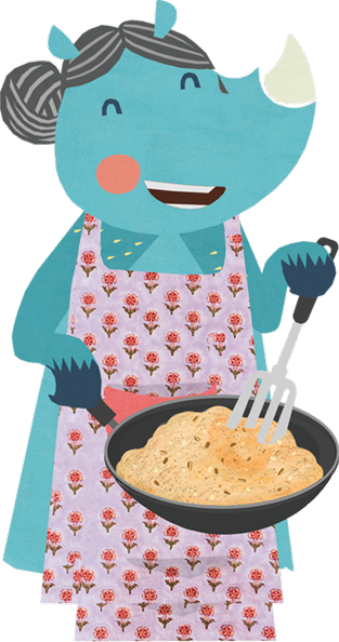Grocery shopping can be a daunting task for parents of newborns. With so many baby products on the market, each with its own claims, it’s tough to pick one.
Start with the basics and make informed decisions to provide your baby with the best nutrition. We’ve put together a guide to help you select the right foods for your little one while shopping.
Start With the Basics: Building Blocks of Your Baby's Diet
1) Fruits and Veggies: Opt for fresh, seasonal produce from local markets. These nutrient-rich options offer vitamins, minerals, fiber, and essential nutrients for your baby's development. Variety is key, so aim to diversify their diet. Remember to wash them thoroughly with water to remove chemical residues.
Fruits and veggies are usually soft (either naturally or when cooked), which is perfect to give your baby so they can experience different textures. Studies show that if babies try lots of different fruits when they are younger, they are more likely to keep eating them as they grow up. When you buy fruits, choose whole ones not pre-cut.
Refer to earlier articles on Introducing Fruits and Introducing Vegetables to your baby’s diet.
2) Dals (Lentils) and Pulses: Rich in iron, protein, fiber, and zinc, these are ideal first foods for your baby! And the best part is they’re a traditional staple in Indian cuisine, often prepared in unique ways from region to region.
Refer to an earlier article on Introducing Pulses and Lentils to your baby’s diet.
3) Grains: Grains are so nutritious especially for growing babies. Choose from various millets (ragi, jowar), rice, wheat, amaranth/rajgira, and oats. Grains offer energy and essential nutrients to your baby.
- Look for traditional whole grain varieties when possible for maximum nutrition.
- Choose whole wheat or millet-based pasta and noodles.
- Opt for whole wheat or whole grain bread; ensure it is low in sodium and contains no added sugar or honey (especially for children under 1).
Refer to earlier articles on Introducing Grains to your baby’s diet:
- Wheat
4) Meat, Chicken, and Eggs: They offer vital nutrients: essential iron (heme iron), protein, zinc, and choline. Some parents worry whether it’s safe to serve nonvegetarian foods to young babies. But don’t worry much. You can safely introduce non-vegetarian options into your baby's diet, modifying them for their age. Opt for organic and grass-fed choices for added safety and nutrition.
Previous Slurrp It Up articles have explored baby-friendly and age-appropriate ways to prepare, cook, and serve nonvegetarian foods. Feel free to check them out:
5) Dairy: While dairy is not suitable as a beverage for babies, milk (animal or plant milk) can be added to or mixed to make other foods like porridges. Additionally, include curd, paneer, unprocessed cheese, and curd, as they are full of essential fats, calcium, and probiotics. These dairy products can also be easy finger foods if you’re on the go.
- Stick to full fat, pasteurized milk.
- Buy full fat, unsweetened/unflavored curd or yogurt.
- Mozzarella cheese and paneer/cottage cheese are low sodium varieties of cheese.
- Try chhena or local varieties of cheese.
- Avoid processed cheese as it’s very high in sodium (popularly sold as slices or cubes).
Refer to an earlier article on Introducing Dairy to your baby’s diet.
6) Oils, Ghee, and Butter: Oils and ghee are good sources of healthy fats and antioxidants. Try local varieties of oils/ghee which you usually use at home.
Refer to the earlier article “Your Guide to Good Fats: Introducing Fats to Fuel Your Baby.”
Cold-pressed oil is gaining a lot of popularity in our country. Compared to refined oils, cold-pressed oils undergo the least amount of processing and have a better nutrition profile. However, they are not suited for high temperature cooking like baking, frying, or slow cooking, as they can burn at higher temperatures.
For high-temperature cooking, filtered or refined oils are the best choice. In India, oils are also fortified with fat-soluble vitamins like A and D, so try to look for those options.
We highly recommend not using hydrogenated fats like vanaspati (or Dalda), which are harmful for babies and adults.
How to Choose Packaged Foods for Your Baby
1) Check the First Ingredient: When you look at the list of ingredients (on the back or side of the pack), the first ingredient name should match what the product claims to be. For example, if it's a “moong dal porridge,” moong dal should be the first ingredient. A ragi porridge will have “ragi” as the first ingredient. If you find this is not the case, it's better to skip it.
|
DID YOU KNOW: The ingredients in the “Ingredients” list are listed in order of the quantity in which they are present. |
2) Watch Out for Sugar: Avoid baby foods with any type of sugar or artificial sweeteners. Some baby foods say they're made from vegetables like spinach but taste sweet because they add sugar.
Sugar can hide in different names. Even if the word "sugar" isn't on the pack, look for words like maltodextrin, sucrose, or sugar syrup.
3) Look for Whole Grains: If the baby food contains whole grains like millets, whole wheat, amaranth, ragi, or oats, it's a healthier choice.
4) Choose Low Sodium: Try to pick baby foods with low sodium (salt). We'll talk more about this in the next article on "Reading Labels."
5) Fiber and Iron Are Great: It's a plus if the baby food is high in fiber and iron. These are good for your baby's health.
6) Look at the Expiry: When buying your baby’s food products, ensure the expiry or “best before” date is okay; it should not be very close to expiring either.
Opt for BPA-Free Foods
You may see the word "BPA-free" when shopping for baby items such as plates, cups, and spoons. BPA (Bisphenol A) is a highly harmful substance and is, in fact, prohibited by the FDA. It can also be present in containers for canned or plastic-packaged foods, so be sure to choose products that bear the "BPA-free" label.
Stay tuned because tomorrow we will cover more in detail how to read labels on packaged baby foods. Being well-informed and equipped with this knowledge can lead to a more positive and less stressful experience when you’re filling up your (physical or virtual) shopping cart!
















